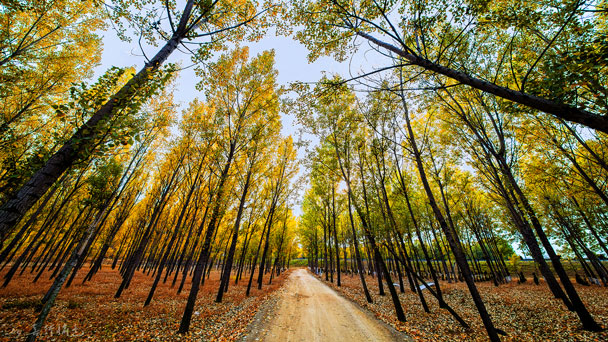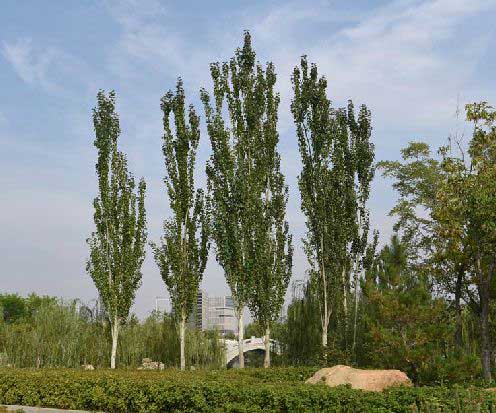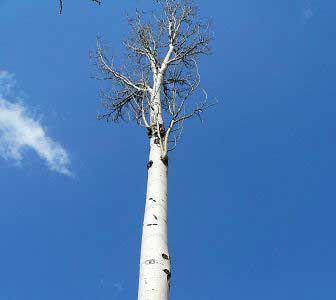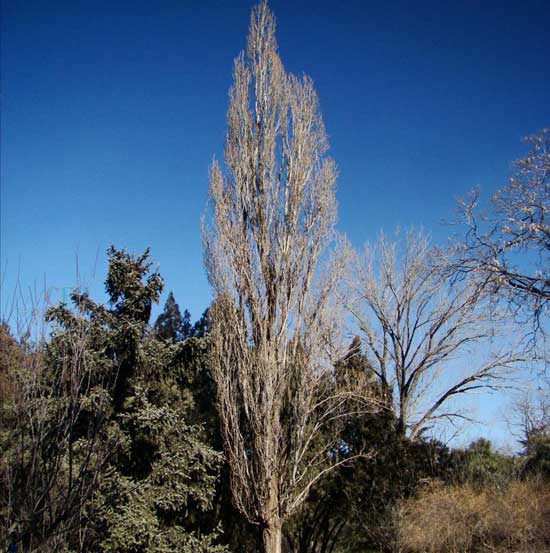Lombardy Poplar Tree Care & Growing Guide
Written by Iris
Oct 30 2021

Lombardy poplar tree (Populus nigra 'Italica') can often be seen towering neatly over the landscape, often used by farmers as windbreaks. Lombardy poplar tree can also happily be included in hedging plans, as they will quickly adapt to being pruned regularly, which will encourage them to sprint and form an effective barrier. With nearly triangular leaves that turn into lovely yellow shades before falling, exposing rough bark, Lombardy poplar tree's dense growth makes it attractive to nesting birds and a good home for many insects.
Lombardy Poplar Trees require heavy watering, which is why they grow best in the Southeastern United States. Even if you do not live in this preferred region, you can grow the Poplar Tree. Water generally collects somewhere on a property. This is generally at the bottom of a hill or valley. Plant your lombardy poplar Trees in this location, as it will be more likely to receive enough water. Sunlight and space are also essential to your Poplar Tree. These trees, which are perfect for fast-growing height, do not grow well in small spaces with minimal sunlight. Your lombardy poplar trees will shine best when planted where it has plenty of space to spread and absorb sunlight.
Lombardy Poplar Tree cuttings do best if taken from healthy trees, especially if taken in the early morning. Use a sharp, thin-bladed knife or sharpened pruning shears and remove all the leaves from the bottom half of a 6-inch stem. If the leaves on your cutting are large, cut them in half to reduce water loss during rooting. Place the cutting up to half its length in a medium made of half peat and half sand; water well and keep in a spot that receives indirect sunlight. Keep the soil moist but not saturated by occasionally misting the cutting. When it has rooted, transfer it into a larger container or into a separate bed with others as its chances of survival are improved if not immediately planted in its permanent location. Cuttings, also called whips, can be harvested in late fall and refrigerated until planting time. If using this method, be sure to soak the cutting for 24 hours before planting and keep the area weed-free during the first two years of growth as young Lombardy Poplar Trees are easily overtaken by other vegetation.

| Botanical Name | Populus nigra 'Italica' |
| Common Name | Lombardy poplar tree, black poplar tree |
| Plant Type | Broadleaf, deciduous tree |
| Mature Size | 40 to 50 feet tall and 10 to 15 feet wide for the 'Italica' cultivar; species plant can become much bigger |
| Light Requirements | Full Sun |
| Soil Requirements | Neutral, Sandy to loamy soil |
| Bloom Time | Spring |
| Color | Red Flower, bright green to blazing golden yellow Leaves |
| Growth Rate | Fast-growing tree |
Where to Grow Lombardy Poplars TreeHow to Grow Lombardy Poplars TreeHow to Care for Lombardy Poplars TreeLombardy Poplar Tree Lighting RequirementsLombardy Poplar Tree Soil CareLombardy Poplar Tree WateringLombardy Poplar Tree Temperature & Humidity CareLombardy Poplar Tree FertilizerLombardy Poplar Tree PruningLombardy Poplar Tree Pests & Diseases CareLombardy Poplars Tree Care FAQHow Fast Dose a Lombardy Poplar Tree Grow?Do Lombardy Poplar Trees lose their leaves?
Where to Grow Lombardy Poplars Tree
How can you grow a Lombardy Poplar Tree in your yard? First know that there are over 30 species of Poplar trees from which to choose. Some may only reach 50 feet while others stretch to 160 feet. Planting a Poplar tree means first determining which species is best suited to your needs.Lombardy Poplar Trees require heavy watering, which is why they grow best in the Southeastern United States. Even if you do not live in this preferred region, you can grow the Poplar Tree. Water generally collects somewhere on a property. This is generally at the bottom of a hill or valley. Plant your lombardy poplar Trees in this location, as it will be more likely to receive enough water. Sunlight and space are also essential to your Poplar Tree. These trees, which are perfect for fast-growing height, do not grow well in small spaces with minimal sunlight. Your lombardy poplar trees will shine best when planted where it has plenty of space to spread and absorb sunlight.

How to Grow Lombardy Poplars Tree
Lombary Poplar trees are planted as cuttings using 8 to 10 segments of one-year old stems. This process is called vegetative propagation and is one way to ensure continuity of the genetic makeup of desired clones. Producing your own cuttings is great way to save money and ensure that you have quality stock year after year. It does, however, require a fair amount of manual labor and storage space.Lombardy Poplar Tree cuttings do best if taken from healthy trees, especially if taken in the early morning. Use a sharp, thin-bladed knife or sharpened pruning shears and remove all the leaves from the bottom half of a 6-inch stem. If the leaves on your cutting are large, cut them in half to reduce water loss during rooting. Place the cutting up to half its length in a medium made of half peat and half sand; water well and keep in a spot that receives indirect sunlight. Keep the soil moist but not saturated by occasionally misting the cutting. When it has rooted, transfer it into a larger container or into a separate bed with others as its chances of survival are improved if not immediately planted in its permanent location. Cuttings, also called whips, can be harvested in late fall and refrigerated until planting time. If using this method, be sure to soak the cutting for 24 hours before planting and keep the area weed-free during the first two years of growth as young Lombardy Poplar Trees are easily overtaken by other vegetation.

How to Care for Lombardy Poplars Tree
Lombardy Poplar Tree Lighting Requirements
Grow Lombardy poplar trees in full sun.Lombardy Poplar Tree Soil Care
Lombardy poplars will do well in soil that is sandy, loamy, or very loamy. It should be well-drained.Lombardy Poplar Tree Watering
During the first year, make sure your tree gets water during extended dry spells, particularly in the summer months. Drooping leaves are a sign of both over or under watering, so ensure you water your lombardy poplar tree about once or twice weekly.Lombardy Poplar Tree Temperature & Humidity Care
The Lombardy Poplar Tree can be grown in a wide variety of temperate climates, including those where the winter low temperature is far below zero. In hot and humid climates, this tree is even more susceptible to Cytospora canker.Lombardy Poplar Tree Fertilizer
Fertilize Lombardy Poplar Tree conservatively. Organic fertilizer high in nitrogen works well. You can use a 10-10-10 or 20-20-20 fertilizer formula. Avoid fertilizing the tree directly. Instead, broadcast the fertilizer around the drip line.Lombardy Poplar Tree Pruning
This low maintenance tree can be pruned to maintain shape and dead or damaged branches can be removed to keep a clean and healthy look. Prune Lombardy Poplar Tree in the winter months during dormancy for best results.Lombardy Poplar Tree Pests & Diseases Care
Lombardy poplars tree (Populus nigra 'Italica') is suseptible to a number of pests and diseases. Cankers are significant problems, especially in hot and humid climates. Cytospora canker attacks the upper branches of the tree and trunk and is often fatal. Additional potential disease problems include dieback, leaf spots, rusts and powdery mildew. Potential insect problems include aphids, borers, caterpillars and scale. Weak wood is easily damaged by wind. Shallow roots can lift sidewalks, make lawn mowing difficult, and damage drainage systems. Falling debris (leaves and twigs) requires frequent clean-up. Also avoid planting this tree in lawns or gardens.
Lombardy Poplars Tree Care FAQ
How Fast Dose a Lombardy Poplar Tree Grow?
Lombardy poplar trees grow rapidly. They could grow to a mature height of up to 60 feet, spreading around 12 feet. However, most are killed by canker disease within 15 years, so large specimens are hard to find. Different varieties of the Poplar tree grow to reach different heights, but all of them are fast-growing. Expect between 3 and 5 feet of new growth a year. Fast growing polar trees typically have shorter lifespans, but several Poplar trees have been documented well over 200 years old.Do Lombardy Poplar Trees lose their leaves?
Lombardy poplars are high-maintenance trees. They create a mess, dropping leaves and twigs that must be swept regularly to keep the area around the tree neat. Due to the tree's brittle wood, branches also break and drop off easily during rough weather.Latest Updated
- Benefits of Bugleweed - 7 Science-backed Health Benefits
- Bugleweed Dangers & Side Effects - Is It Poisonous?
- How to Plant Evergreen Trees - What You Should Know
- When to Plant Evergreens - Grow Guide for Evergreen Trees
- 12 Wonderful Evergreen Shrubs for Your Garden
- 12 Popular Evergreen Plants with Pictures for Beginners
- When And How To Prune A Lilac Bush Like a Pro
- How to Grow & Care for Lilac Vine (Hardenbergia Violacea)
- Japanese Lilac Tree (Syringa Reticulata) Care & Propagation Guide
- Shumard Oak Pros and Cons - What to Know
Popular Articles
- Winter maintenance of Antirrhinum Majus
- How to Grow Terminalia Mantaly Tree
- How to Grow and Care for Crossostephium Chinense
- How to grow Antirrhinum Majus in spring
- Peristeria Elata (Dove Orchid) Profile: Info & Care Guide
- Underwatered Snake Plant (Sansevieria Trifasciata) - Signs And How To Fix
- How to Care for Brazilian Jasmine Plant (Mandevilla Sanderi)
- How to Grow & Care for Graptopetalum Purple Delight in Summer
- Rosa Chinensis (China Rose): Plant Growing & Care Tips
- How to Care for Baby Sun Rose (Aptenia Cordifolia)